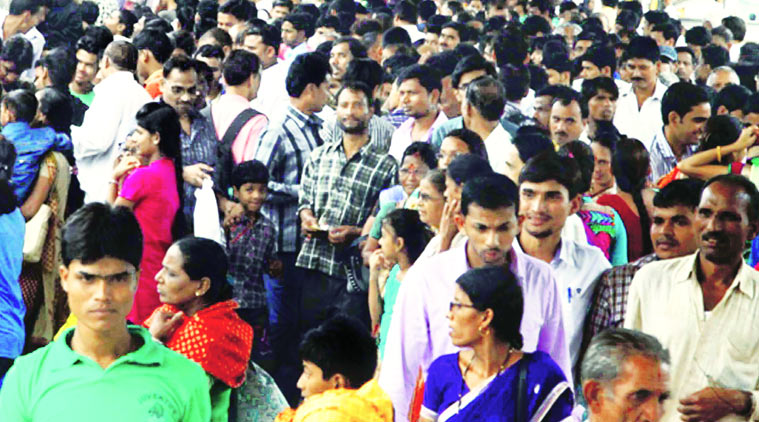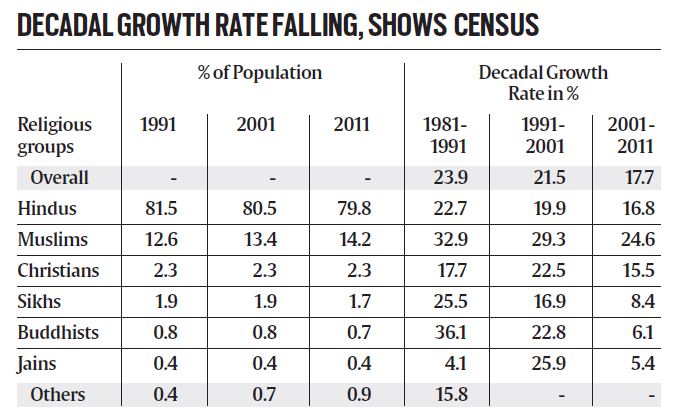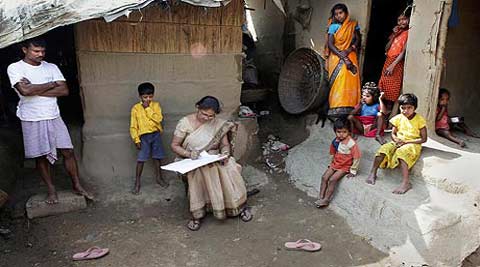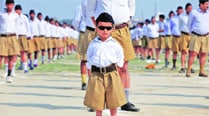Population growth slowing for all; on sex ratio, Muslims better than Hindus
While decadal growth rates are declining among all religious communities, the decline has been sharper among Muslims than among Hindus over the last three decades.
 The share of Hindus in the population came down marginally from 80.5% in 2001 to 79.8% in 2011. In 2001, Muslims constituted 13.4% of the country's population; this went up marginally to 14.2%.
The share of Hindus in the population came down marginally from 80.5% in 2001 to 79.8% in 2011. In 2001, Muslims constituted 13.4% of the country's population; this went up marginally to 14.2%.The Census 2011 data on Population by Religious Communities, released by the Registrar General and Census Commissioner of India, confirms the declining trend in population growth rate in the country. While decadal growth rates are declining among all religious communities, the decline has been sharper among Muslims than among Hindus over the last three decades. In fact, the decadal growth rate among Muslims during 2001-11 is the lowest it has ever been. However, inter-state and inter-regional variations need to be analysed.
 The Total Fertility Rate (TFR) is falling faster in Muslims than in Hindus. In the National Family Health Survey (NFHS) 1 (1992-93), fertility numbers for Muslims and Hindus were 4.4 and 3.3, a gap of 1.1. In NFHS 2 (1998-99), the numbers for Muslims and Hindus fell to 3.59 and2.78, and the gap, therefore, to 0.8. And in NFHS 3 (2005-06), the numbers were 3.1 and 2.7; the gap 0.4.
The Total Fertility Rate (TFR) is falling faster in Muslims than in Hindus. In the National Family Health Survey (NFHS) 1 (1992-93), fertility numbers for Muslims and Hindus were 4.4 and 3.3, a gap of 1.1. In NFHS 2 (1998-99), the numbers for Muslims and Hindus fell to 3.59 and2.78, and the gap, therefore, to 0.8. And in NFHS 3 (2005-06), the numbers were 3.1 and 2.7; the gap 0.4.The share of Hindus in the population came down marginally from 80.5% in 2001 to 79.8% in 2011. In 2001, Muslims constituted 13.4% of the country's population; this went up marginally to 14.2%. In absolute numbers, the Hindu population increased by 13.9 crore during 2001-11; the Muslim population increased by 3.4 crore.
The fertility rate is falling faster in Muslims than in Hindus. Data from the last three National Family Health Surveys (NHFS) show that the gap between Muslim and Hindu fertility rates is narrowing — the difference came down from 1.1 in NFHS 1 (1992-93) to 0.4 in NFHS 3 (2005-06). But the difference in fertility rates of the two communities is bigger in some states and union territories, and needs separate analysis.
The other important piece of data is sex ratio, which is the number of women per 1,000 men. Sex ratio among Muslims as per Census 2011 was 951 — better than the 939 among Hindus. Also, sex ratio among Muslims improved significantly over the decade — from 936 in 2001 to 951 in 2011. The improvement was smaller among Hindus — from 931 in 2001 to 939 in 2011.
These demographic trends are along expected lines. With increased access to education and better economic opportunities, a decline in fertility follows naturally.
It must be noted, however, that fertility among the followers of a particular religion varies substantially across states. Fertility among Hindus is higher in UP than in Tamil Nadu, and the same holds true for Muslims as well. The Census data show that the rate of growth of population varies from state to state. In states like Kerala, Tamil Nadu and [undivided] Andhra Pradesh, which provide better access to education and development opportunities, the decline in fertility has been substantial.
Kerala stands out with its social sector achievements, leading to the low fertility situation in the state. The social factors that adversely affect India's efforts at achieving rapid population stabilisation include widespread deprivation, inequality and social and gender discrimination.
The Census data suggest that there is no "Hindu fertility" or "Muslim fertility" or "Christian fertility" as such. The religious fertility differentials seen in India at present are on account of the differences in the stages of transition that these communities are at, and not the absence of transition in any community. There is nothing in a religion or approach to life that leads a community to have larger families, rather, one should look at their economic circumstances, poverty, marginalisation, etc.
Indonesia and Bangladesh, both developing, Muslim-majority countries, have outperformed India in terms of falling birth rates. What may have made the difference is female education and employment opportunities, and access to a bigger basket of choices in contraception. Bangladesh probably has economic indicators and per capita income that are similar to some large Indian states.
Women's education is the most important factor explaining fertility differences across the country and over time. The Census data on religious communities provide an opportunity to plan and construct suitable development interventions geared towards education, gender equity, economic development and access to family planning, irrespective of culture or religion.
The author is Executive Director, Population Foundation of India.
- See more at: http://indianexpress.com/article/explained/population-growth-slowing-for-all-on-sex-ratio-muslims-better-than-hindus/#sthash.sskHncNV.dpuf






No comments:
Post a Comment